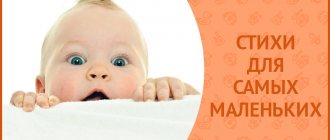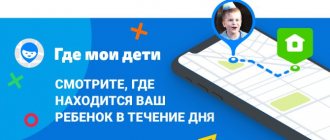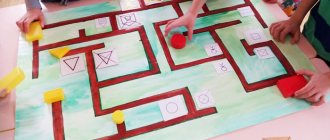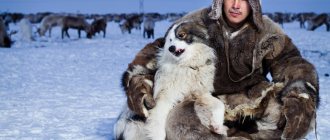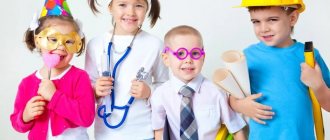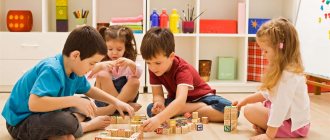Stories for the little ones: how to choose books with stories for the little ones, what to look for when reading, how to teach them to understand books without pictures. Texts of stories for reading to children 1-2 years old.
The selection of children's books in stores is now huge! And books - toys, and books - cut-outs in the shape of various animals, cars, nesting dolls, toys, textile books for the development of fine motor skills, books - lacing, floating waterproof books for swimming, talking books, music books, huge thick collections of poems and fairy tales for the little ones. And it’s wonderful that from the very first years of life a child has the opportunity to get acquainted with beautiful and interesting children’s books in all their diversity.
But today we’ll talk about other books - traditional story books for kids . They are less popular than books with fairy tales or poems, but young children really need them! It is in stories that a child becomes more familiar with the world around him, with the lives of people.
How to choose story books for little ones?
First. For reading to the little ones, thin books with pictures are more suitable than thick collections of fairy tales or short stories. One book is one story in pictures, or several short stories.
Second. Pictures in a book for children 1-2 years old should be realistic. That is, the illustrations in the book should not contain blue cows or hares with short ears and long tails. From the picture, the baby should get an accurate idea of the world around him; children of this age do not yet understand humor! Illustrations are needed to clarify ideas about the world, and not to confuse the child. Naturally, realism does not exclude decorative details - let us remember, for example, illustrations for fairy tales by the famous artist Yu. Vasnetsov.
The perspective in which the hero of the story is depicted is very important - all the heroes of the story should be easily recognizable by the child in the pictures.
Third. At the early stage of understanding literature, a drawing represents for a child the very life around him, which cannot be replaced by a word. Therefore, it is necessary that the child can use the pictures to follow step by step what they are telling him about (remember the story “Chicken” by K.I. Chukovsky).
For the youngest children, a picture book is alive! They feed the drawn horse, pet the cat, talk to the pictures, and can even wait for “the bird to fly away” from the picture.
Fourth. It is very important that the baby’s first books are beautiful. It is at an early age that children develop an understanding of beauty. They like beautiful clothes, a beautifully decorated room, beautiful flowers or beautiful pictures. And they clearly prefer beautiful objects and books.
Summary of a lesson on speech development in the middle group. Retelling of the story “Train” by Y. Taits
Elena Korchik
Summary of a lesson on speech development in the middle group. Retelling of the story “Train” by Y. Taits
Summary of a lesson on speech development in the middle group.
Retelling the story I. Thai " Train "
Compiled by a kindergarten teacher
№89 "Thumbelina"
Bryansk Korchik Elena Mikhailovna
Goal: teach children to retell a short story .
Connected speech: learn to independently retell a fairy tale , convey direct speech ;
Sound culture of speech : clarify the correct pronunciation of the sound C in words. Pronounce words with the S sound clearly and clearly.
Equipment and materials: picture for story I. Thai " Train "
, Painting
"Sasha and the Snowman"
.
How to read stories to little ones: 4 simple rules
First. Stories can and should not only be read from a book, but also told! And this is very important! What is the benefit of storytelling? The fact is that in the case of storytelling, your word is a “living word”!
When you tell a child a simple story, a fairy tale or a short story, you look into his eyes, you can pause if necessary, slow down the pace of speech, introduce a new intonation. You see the baby’s reaction to the story and can take it into account. In addition, the child sees your face, emotions, and the process of your speech.
Therefore, it is better to first get acquainted with the story , and then read it to the baby. If you are “attached” to the text and bury yourself in it while reading, then the baby will quickly become distracted and lose interest.
Reading a story is our dialogue with a child about the book, but not a monologue of an adult buried in the text.
It’s wonderful when you know your favorite stories by heart and tell them simply from the heart at the right moment - without a book.
I have a system of cards with short stories and poems - they are always with me. And at the right time you can always use them if you need to remember something.
Second. If you bring home a new book, you don’t need to start reading it right away. First, give the book to your baby - let him get to know it, examine it, leaf through the pages, look at the pictures and play with them - feed the horse, share his impressions with you (this can be just exclamations, pointing gestures, intonations, if the baby does not speak yet ).
After the first acquaintance with the book, look at the pictures with your child, tell the child what is drawn on them. In this case, it is better to quote words from the text of the story, which the child will later hear when reading it. For example: “Masha has a sled. Misha has a sled. Tolya has a sled. Galya has a sled. One dad without a sled” (based on the story by Ya. Taits). Pay attention to interesting or unusual details in the illustrations (the clothes of the characters, objects in their hands, what is around them), examine them and name them.
After the first acquaintance with the book, you can read the story to your baby. If you start reading a new book right away, then the children will not listen - they reach for the book, want to pick it up, want to turn the pages, stroke the cover, and begin to get distracted.
Third. At the age of 1 year 6 months to 2 years, it is very important to teach the child to perceive a story without visual support (i.e., without a picture or dramatization of the content of the story). Otherwise, the baby may develop a not very useful habit. This is the habit of waiting for toys to be shown and saying words only under this condition. If you do not teach your child to listen to speech before the age of 2, then in the future the child will have difficulty engaging in dialogue, constantly demands pictures, does not answer questions, does not perceive audio recordings or reading books without pictures, and has difficulty perceiving speech by ear without visual support. You will find examples of stories to read to children without visual support below.
What stories can children understand without pictures?
- Up to 2 years old , children understand adults’ stories about events that are happening at a given moment in time or are very familiar to them.
- After 2 years, children begin to understand, without showing pictures, the stories of adults about events that are familiar to them from past experience.
- And from the age of 2 years 6 months, children begin to understand, without showing pictures, adults’ stories about events that did not happen in their lives, but they are familiar with similar phenomena or with individual elements of the story’s plot. Also, from 2 years 6 months, a child can convey the content of a familiar fairy tale or story based on questions (that is, he can answer an adult’s questions about the content of the story).
Fourth. What to do first - watch a cartoon based on the story or read the text of the story? First, we introduce the child to the book - look at the illustrations, read the story. This is the base. And later you can watch a cartoon based on a familiar story book. In a cartoon, most often the child does not perceive the text, because... captivated by flashing pictures.
Train story for Thai children
There are many good short stories in Russian literature for children that are suitable for reading to preschoolers of all ages.
This is also good reading practice for kids learning to read. It is still difficult for them to read large books. But short stories created specifically for such circumstances are quite suitable. An example is short stories for children by the Soviet writer Yakov Taits. He not only wrote books, but also, being an artist, illustrated them himself.
Thai's short stories are written in a language that modern children can understand. This is important given the current state of oral speech.
Stories for little ones K.D. Ushinsky
Mice. K.D. Ushinsky
Mice, old and small, gathered at their hole. They have black eyes, small paws, teeth, gray fur coats, ears sticking out at the top, tails drag along the ground.
Vaska. K.D. Ushinsky
Cat-cat - gray pubis. Vasya is affectionate and cunning: velvet paws, sharp claws. Vasyutka has sensitive ears, a long mustache, and a silk fur coat. The cat caresses, bends over, wags its tail, closes its eyes, and sings a song.
Cockerel with his family. K.D. Ushinsky
A cockerel walks around the yard: he has a red comb on his head and a red beard under his nose. Petya's nose is a chisel, Petya's tail is a wheel; there are patterns on the tail, spurs on the legs. Petya rakes the pile with his paws and calls the hens and chicks together: “Troublesome housewives! Get your chickens together, I brought you some grains!”
Goat. K.D. Ushinsky
A shaggy goat walks, a bearded goat walks, waving its faces, shaking its beard, tapping its hooves: it walks bleating, calling for goats and kids.
Sow. K.D. Ushinsky
The sow's snout is not elegant: its nose rests on the ground; mouth to ears, and ears dangling like rags; Each leg has four hooves, and when it walks, it stumbles. The sow's tail is like a screw, its ridge is humped, and stubble sticks out on the ridge. She eats for three, gets fat for five.
Geese. K.D. Ushinsky
The hostess came out and beckoned the geese home: “Pull-pull! White geese, gray geese, go home!”
And the geese stretched out their long necks, spread their red paws, flapped their wings, opened their noses: “Giga! We don't want to go home! We feel good here too!”
Cow. K.D. Ushinsky
The cow is ugly, but she gives milk. Her forehead is wide, her ears are to the sides, there are not enough teeth in her mouth, but her face is large. She tears grass, chews gum, drinks swill, moos and roars, calling for her mistress.
Eagle. K.D. Ushinsky
The blue-winged eagle is the king of all birds. He builds nests on rocks and on old oak trees; flies high, sees far. The eagle has a sickle nose, hooked claws, long wings; An eagle flies in the clouds, looking for prey from above.
Woodpecker. K.D. Ushinsky
Knock-Knock! In a deep forest, on a pine tree, a black woodpecker is carpentering. It clings with its paws, rests its tail, taps its nose, scares away ants and boogers from behind the bark.
Lisa Patrikeevna. K.D. Ushinsky
The godmother fox has sharp teeth, a thin snout, ears on the top of her head, a tail that flies away, and a warm fur coat. The godfather is well dressed: the fur is fluffy, golden, there is a vest on the chest, and a white tie on the neck. The fox walks quietly, bends down to the ground, as if bowing. He wears his fluffy tail carefully; digs deep holes with many entrances and exits; loves chickens, ducklings, not rabbits.
The next two stories are stories from the 20th century. They are written in a very accessible language and are understandable to children even without pictures.
Stories for little ones Ya. Taits
Story by Ya. Taits “Geese”
My grandmother had geese on the collective farm. They hissed. They pinched. They were talking to each other: “Ha-ha!” "Ha-ha!" “Yeah!” "Ha-ha!" “Yeah!” Nadya was afraid of them. She shouted: “Grandma, geese!” Grandma said: “You take a stick.” Nadya took a stick, and how could she swing at the geese? - Get out of here! The geese turned and walked away. Nadya asked: “Are you scared?” And the geese answered: “Aha!”
Story by Ya. Taits “Train”
There's snow everywhere. Masha has a sled. Misha has a sled. Tolya has a sled. Galya has a sled. One dad without a sled. He took Galina's sled, hitched it to the Tolins, Tolina - to the Mishins, Mishins - to the Mashins. It turned out to be a train. Misha shouts: - Tu-tu! He is a machinist. Masha shouts: “Your tickets!” She's a conductor. And dad pulls the string and says: “Choo-chuh... Chuh-chuh... So he’s a locomotive.”
At the age of 1 year 6 months to 2 years, it is very important to start teaching a child to listen to stories without visual support - that is, without showing pictures based on the content of the story, without dramatizing or showing toys. I have made a selection of such stories for children, which they understand from the content itself. In the collection, the stories are grouped by age: from 1 year 9 months to 2 years, from 2 years to 2 years 6 months, from 2 years 6 months to 2 years 11 months.
OOD summary for getting acquainted with the story “Train” by Yakov Taits
Gordienko Natalya
OOD's notes on getting acquainted with the story "Train" by Yakov Taits
Summary of organized educational activities on cognitive and artistic development for young children.
Educator: Gordienko Natalya Sergeevna.
Class. Introduction to the story of Yakov . Thai " Train "
Topic: It's bad to be alone.
Target. Improve your ability to listen to a story .
– bring to the consciousness of children the content of the story “
Train ” (it’s bad to be alone)
;
– develop children’s interest in various types of games, encourage active activity.
– enrich children’s vocabulary.
Material for the lesson:
1. Story . '' Train"
2. Illustrations for the story .
Stories for children 1-2 years old without showing
We teach kids to listen and understand speech without visual support (that is, without a picture, scene, or display of objects)
Stories without showing for children from 1 year 9 months to 2 years
Sveta and the dog (Author – K.L. Pechora)
Sveta went for a walk, put on a hat and coat and walked with her feet - stomping. And there the dog barks: “Aw-aw!” Don't be afraid, Sveta, the dog doesn't bite!
Who went for a walk? Who did she meet?
Feeding the cat. Author – K.L. Pechora
The cat came home and meowed: “Meow-meow.” He wants to eat. Mom poured milk for the cat and said: “Here, kitty, drink milk!” And the cat drank the milk.
- Who did I tell you about?
- What was the cat doing?
- What did mom give her?
Stories for children from 2 years to 2 years 6 months without showing
Tanya will sleep. Author – K.L. Pechora
The girl Tanya is tired. I played all day. Mom said: Let's go babes. I'll put you on the bed. I’ll sing a song.” Tanya doesn't want to sleep Ay-ay-ay! All the kids are already asleep. Tanya lay down on the bed. She closed her eyes, and her mother sang a song to her: “Bayu-bayu-bayu. I’m rocking Tanya.” Quiet, guys. Tanya is sleeping.
You can repeat the story twice. Questions for your child to check their understanding of speech: - Who did I tell you about? - What did mom sing to Tanya? - Tanya doesn’t want to sleep? Ah ah ah. -Where did mom put Tanya? - Did Tanya fall asleep?
Ball. The author of the story is L.S. Slavina
Once upon a time there lived a boy, Petya. He had a dog, Sharik. Once Petya called Sharik: “Sharik, Sharik, come here, I brought you meat.” But Sharik is not there. Petya began to look for him. Sharik is nowhere to be found: neither in the garden nor in the room. But Sharik hid under the bed, and no one saw him there.
Doll bed. The author of the story is L.S. Slavina
Once upon a time there was a girl Galya, she had a doll Katya. Galya played with the doll and put her to bed in her crib. Suddenly the crib broke. There is nowhere for the Katya doll to sleep. The girl Galya took a hammer and nails and repaired the crib herself. The doll now has a crib.
Tanya and brother. The author of the story is L.S. Slavina
Once upon a time there lived a girl, Tanya. She had a little brother, a little boy. Mom gave the kids something to eat and left. Tanya ate and began to play, but her little brother could not eat on his own, he began to cry. Then Tanya took a spoon and fed her brother, and then they began to play together.
Ship. The author of the story is L.S. Slavina
Once upon a time there lived a girl, Natasha. Dad bought her a boat from the store. Natasha took a large basin, poured water and let the boat float, and put a bunny in the boat. Suddenly the boat capsized and the bunny fell into the water. Natasha pulled the bunny out of the water, dried him and put him to bed.
Assistants. The author of the story is N. Kalinina
Sasha and Alyosha helped set the table. Everyone sat down to dinner. The soup was poured, but there was nothing to eat. That's it, helpers! The table was set, but no spoons were placed.
Cube upon cube. The author of the story is Ya. Taits
Masha puts cube on cube, cube on cube, cube on cube. She built a high tower. Misha came running: - Give me the tower! - I'm not giving it! - Give me at least a cube! - Take one cube! Misha reached out his hand and grabbed the lowest cube. And instantly - bang-bang-bang! — the whole Machine Tower has collapsed!
River. The author of the story is Ya. Taits
Our Masha doesn’t like porridge, she shouts: “I don’t want it!” Don't want!" Mom took a spoon and ran it over the porridge, creating a path. Mom took the milkman, poured milk, and it turned out to be a river. - Come on, Masha, drink from the river and eat by the shore. I drank the whole river, ate all the banks, only one plate remained.
Stories without showing for children from 2 years 6 months to 2 years 11 months.
About the girl Katya and the little kitten.
OOD progress:
1. Surprise moment.
Educator: Guys, look, today a letter arrived in our group . Who do you think it's from?
Educator: That's right - from the snowman.
Educator: Let's read the letter.

"Hello guys. Winter is already ending, it will soon become warm. And you will completely forget about winter fun. And so that you don’t forget, I’m sending you a picture with my favorite item. Don't be bored without me! Goodbye".
The teacher shows a picture of a sled.
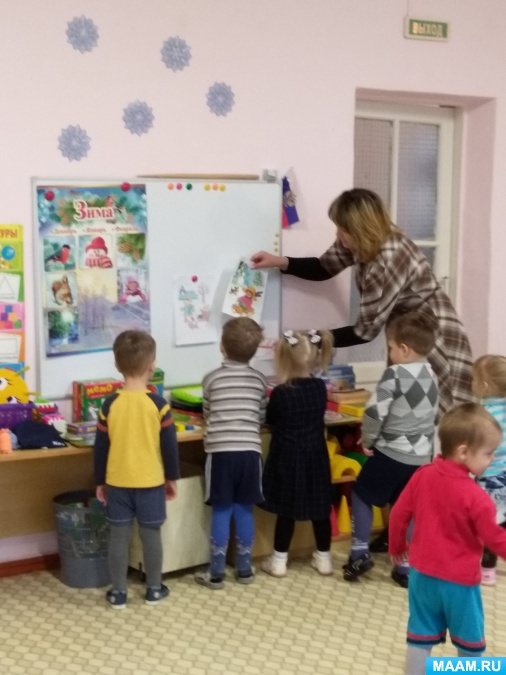
Educator: Do you guys know what this is? What are sleds for?
Educator: Look, here we have pictures, they show children sledding.
(Conversation based on pictures.)
Educator: I want to tell you a story about how the guys sledded.
Reading a story
Educator: A driver is a train . The conductor is the person who checks the tickets. Educator: Here's another way to sled! Make a train . Can we play train ?
Educator: But we know how to play the game “Our children got into the sleigh”
P/I “Our children got into the sleigh”
Educator: That's how fun it is. story to you again .
(Conversation on content)
.
What were the children's names? Who didn't have a sled? Who was first ?
D/I “Assemble a train from a sled ”

Educator: Who sent us the letter? What else did you like?
OOD for speech development “Cockerel and his family” in the first junior group of the MBDOU kindergarten “BELOCKA” in the Olkhovatsky municipal district of the Voronezh region. OOD on speech development On the topic: “Cockerel and his family.” The use of finger theater in educational activities for speech development in the first junior group. In my work with young children, I use crocheted finger theater based on the fairy tales “Teremok” and “Zayushkina’s Hut.” Abstract of educational activities on cognitive development in the 1st junior group “Forest inhabitants” Abstract of educational activities on cognitive development in 1st junior group “Forest inhabitants”. Conducted by: teacher Novikova V.V. Purpose: To give the children an idea.
Abstract of the OOD on speech development in the first junior group “Visiting the Bunny” MUNICIPAL BUDGETARY PRESCHOOL EDUCATIONAL INSTITUTION COMBINED KINDERGARTEN No. 87 “DAWN” BRYANSK Abstract.
Abstract of educational activities on social and communicative development in the first junior group “Toys” Abstract of educational activities on social and communicative development in the first junior group “Toys” Description: This lesson allows children to remember.
Summary of educational activities in the first junior group on speech development “Water-water” MBDOU Syavsky kindergarten “Bell” Summary of educational activities on speech development Topic: “Water, water”.
Summary of a lesson on speech development in the first junior group “Hen and Chicks” on speech development and modeling Topic: “Hen and Chicks” Objectives: Enrich children’s vocabulary (hen, chickens, chick, pecks); promote the use of simple phrases; encourage.
Lesson summary in the first junior group “Fun Train” Lesson summary in the junior group 1 on the topic: “Fun Train” Lesson topic: “Fun Train” (natural world) Program content:.
Acquaintance with the story of Yakov Taits “Train” Lesson notes on speech development. Introduction to the story “The Train” by Yakov Taits. Purpose: Educational: improve listening skills.
Source
